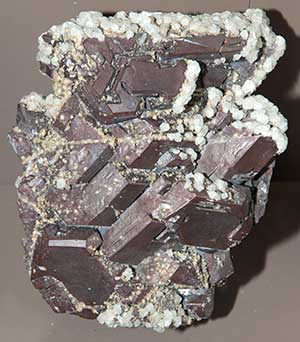 |
|
Galina - PbS.
|
Lead is a very corrosion-resistant, dense, ductile (which means that it can be drawn into wires or pressed into thin sheets), malleable blue-gray metal that has been used for at least 5,000 years. The most significant lead mineral is galena (lead sulfide). Leading producers are in Australia, China, Peru, and the United States. More than three-fourths of lead is used by the transportation industy, mainly for lead-acid batteries. Remaining uses include ammunition, electrical, electronic, and communication applications, and radiation shields.
Background
Lead, atomic number of 82, is very soft, blue-gray, metallic element and has been used since antiquity. Because it is so soft, lead is usually alloyed with other elements. Water pipes in ancient Rome, some of which still carry water, were made of lead. The English words plumber and plumbing are derived from the Latin word for lead, plumbum. Plumbum is also the source of the chemical symbol for lead, Pb.Lead is a very heavy element. Native lead was found in Sweden, but it is rare to have the element alone in nature. Combined with other elements, it forms a variety of interesting and beautiful minerals, all of which are heavy due to their lead content. The most significant lead mineral is galena (PbS, lead sulfide). Galena deposits have been worked worldwide for their lead. During the Civil War, the Union Army made bullets from lead derived from a galena mine at Balmat, New York. Anglesite and cerussite ((PbSO4, lead sulfate and PbCO3, lead carbonate respectively) are two other lead-based minerals.
All major radioactive elements (such as uranium) break down and create lead as one of their end products. Interestingly, lead is used to safely store radioactive materials because it absorbs radiation from the radioactive isotopes.
Lead is toxic. It can cause damage to the digestive and nervous systems, so its use in some applications has been discontinued. Lead poisoning is monitored in children to prevent any permanent damage. At one time lead was added to gasoline to eliminate "knock" in car engines. It was also in paint, but the lead-based paints have a sweet taste, and some children were eating the paint and getting serious lead poisoning.
Name
Although it is believed that it comes from an Anglo-Saxon background, the exact origins of the name lead are unknown.
Sources
It is estimated that the identified lead resources worldwide exceed 1.5 billion tons. Much lead is recovered as the primary metal from galena deposits. Significant amounts of lead are being recovered as a by-product or co-product from zinc mines, and silver-copper deposits.
In the United States, mines in Missouri, Alaska, Idaho and Montana produced the majority of lead. Lead is also imported into the United States from a number of countries, both as ore concentrates and as metallic lead. Canada is the most important importer, followed by Mexico, Australia, and Peru.
More than 1 million tons of lead is recovered in recycling annually, the majority of which is from the recycling of batteries.
Uses
The majority of the lead consumed annually is used to make batteries for cars, trucks and other vehicles, as well as wheel weights, solder, bearings and other parts. Lead is used in electronics and communications (emergency power batteries, for example), ammunition, television glass, construction, and protective coatings. A small amount is used to make protective aprons for patients having x-rays to shield the body from excess radiation exposure, for crystal glass production, weights and ballast, and specialized chemicals.
Substitutes and Alternative Sources
Plastics, aluminum, tin, and iron are replacing the use of lead in construction materials, containers, packaging, etc. Tin and other metals are being used to replace lead as a solder in some applications where lead could poison people, such as in drinking water systems.